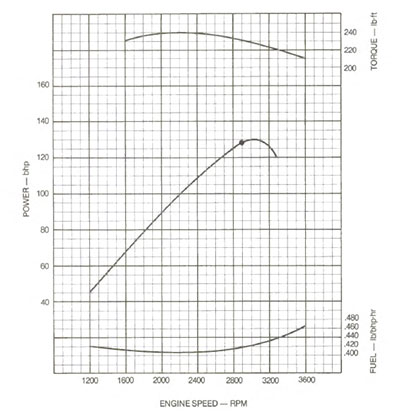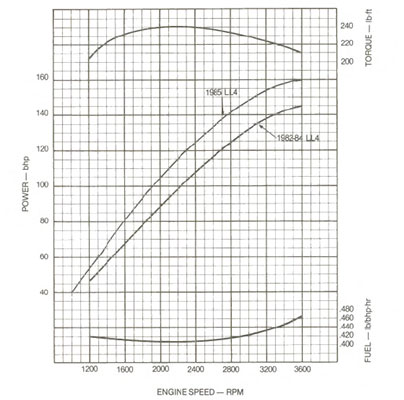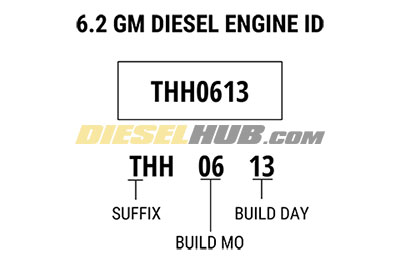Farmers could haul hay and tools around the ranch without tearing deep into their pockets, and make it to the feed store on a budget. While the 6.2 diesel was no heavy hauler, it certainly appealed to a particular niche market. In the long run, the 6.2 would prove to have some reliability concerns including reoccurring overheating issues, cracked engine blocks, and failures of the harmonic balancer, crankshaft, and flywheel (the three of which are often related to one another). The 6.2L shares the same bellhousing bolt patterns and motor mounts as all GM V-8 gas engines, simplifying production and integration of the diesel power plant into C/K series pickups.
6.2L GM Diesel Specs
| Manufacturer | Detroit Diesel ( a division of General Motors at time of inception) | |
| Production Years | 1982 - 1993 | |
| Applications | GM/Chevrolet C/K trucks, Hummer H1, Jimmy, Suburban | |
| Configuration | 90° V-8 | |
| Block/Head Material | Cast iron engine block, cast iron cylinder heads | |
| Displacement | 379 cubic inches, 6.2 liters | |
| Firing Order | 1-8-7-2-6-5-4-3 | |
| Cylinder Numbers |  |
|
| Compression | Early 1982 LL4 | 20.3 : 1 |
| Late 1982+ LL4 | 21.3 : 1 | |
| LH6 (all years) | 21.5 : 1 | |
| Bore | 3.98 inches (3.976 inches, 101 mm) | |
| Stroke | 3.82 inches (3.8189 inches, 97 mm) | |
| Injection | • IDI (indirect injection) • Mechanical injectors, Stanadyne DB-2 rotary injection pump |
|
| Valvetrain | Overhead valve (OHV) pushrod engine (standard cam-in-block), hydraulic roller lifters | |
| Aspiration | Naturally aspirated; factory turbocharger not offered | |
| Nominal Dimensions | Length | 29.5 inches |
| Width | 27.2 inches | |
| Height | 27.4 inches | |
| Engine Oil Capacity | 7 qts w/ filter (use ACDelco PF1218) | |
| Engine Oil Spec | SAE 30 | ambient temperature > 32° F (preferred viscosity within temp range) |
| SAE 15W-40 | ambient temperature > 0° F | |
| SAE 10W-30 | ambient temperature < 60° F | |
| Fuel Requirements | # 2 diesel | ambient temperature > 20° F |
| # 1 diesel | ambient temperature < 20° F, can substitute with winterized # 2 diesel fuel if necessary | |
| Biodiesel | engine not factory certified to run on biodiesel | |
| Dry Weight | Approx 700 lbs | |
| Normal Operating Temp | 190 - 230° F | |
| Idle Speed | 650 rpm (+- 25 rpm) | |
| Max Engine Speed | 3,600 rpm (4,000 w/ no load) | |
| Horsepower | • 130 hp @ 3,600 rpm (introductory) • 160 hp @ 3,600 rpm (peak) |
|
| Torque | • 240 lb-ft. @ 2,000 rpm (introductory) • 275 lb-ft. @ 2,000 rpm (peak) |
|
The 6.2L became available following the retirement of the infamous 5.7L Olds diesel. It was available in 1/2 ton as well as 3/4 and 1 ton model pickups, which is unique to GMC/Chevrolet because Ford and Dodge never offered diesels in their 1/2 ton pickups when they entered the diesel sector in 1983 and 1989, respectively. At an option of less than $1,500 and capable of surpassing some of GM's V-6 gas engines in fuel economy, the 6.2 diesel was an attractive offer. The engine's were Federally rated at up to 23 mpg combined and GM estimated up to 31 mpg on the highway. GM secured a government contract and provided 6.2L diesel engines and trucks to the United States Army in mass quantities, many of which can still be affordable purchased at government auctions. Despite some of the problems that plagued the 6.2L diesel in the long run, the engine ultimately achieved what GM/Detroit had set forth to do and paved the way for future endeavors in the diesel sector.
6.2L Diesel RPO Codes
| RPO Code | VIN | Horsepower (hp @ rpm) |
Torque (lb-ft @ rpm) |
Notes | ||
| LH6 | C | 1982 - 1989 | 130 @3,600 | 1982 - 1989 | 240 @ 2,000 | Light duty engine w/ exhaust gas recirculation (EGR), GVWR < 8,500 lbs |
| 1990 - 1993 | 143 @ 3,600 | 1990 - 1993 | 257 @ 2,000 | |||
| LL4 | J | 1982 - 1984 | 135 @ 3,600 | 1982 - 1984 | 240 @ 2,000 | Heavy duty engine w/o exhaust gas recirculation (EGR), GVWR > 8,500 lbs |
| 1983 industrial | 145 @ 3,600 | 1983 industrial | 240 @ 2,000 | |||
| 1985+ | 160 @ 3,600 | 1985+ | 275 @ 2,000 | |||
6.2L Diesel Horsepower & Torque Curves


6.2L Diesel Engine Identification, Build Date
All 6.2L GM diesels have a 7 digit engine identification number stamped into the engine block below the intake runner of the number 1 cylinder. GM refers to this 7 digit sequence as the "broadcast code". An example of a broadcast code is as follows:

| Suffix Letter | Model Year | Suffix Letter | Model Year |
| T | 1982 | D | 1985 |
| U | 1983 | H | 1986 |
| F | 1984 | J | 1987 |
The broadcast code identifies the model year, build month, and build day.
6.2L GM Diesel Engine Oil Spec and Block Heater Schedule
Under normal operating conditions, the engine oil in a 6.2L GM diesel should be replaced every 5,000 miles or 12 months, whichever comes first. Under severe/heavy duty operating conditions, which includes periods of excessive idling, towing, and off-road driving (especially in dusty conditions), the engine oil should be replaced every 2,500 miles or 3 months, whichever comes first.
| Oil Viscosity | Acceptable Temperature Range | Notes |
| SAE 30 | ambient temperature > 32° F | preferred viscosity within listed temperature range |
| SAE 15W-40 | ambient temperature > 0° F | acceptable viscosity within listed temperature range |
| SAE 10W-30 | ambient temperature < 60° F | required cold weather viscosity |
In addition to adhering to the engine oil viscosity chart above, the following block heater schedule should be used in cold weather:
| Oil Viscosity | Ambient Temp > 32° F | Ambient Temp 32° F to 0° F | Ambient Temp < 0° F |
| SAE 30 | block heater not required | use block heater min 2 hours | use block heater min 8 hours |
| SAE 15W-40 | block heater not required | block heater not required | use block heater min 8 hours |
| SAE 10W-30 | block heater not required | block heater not required | use block heater min 8 hours |
Failure to use the engine block heater in cold weather may compromise longevity, contribute to excessive engine wear, and possibly damage engine. The engine block heater can be plugged in longer than listed in the schedule above without any negative effects or concerns, i.e. being left plugged in overnight.